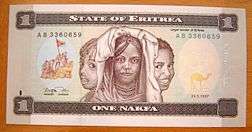Eritrean nakfa
| Eritrean nakfa | |
|---|---|
|
1 nakfa banknote | |
| ISO 4217 | |
| Code | ERN |
| Denominations | |
| Subunit | |
| 1/100 | cent |
| Symbol | Nfk (Latin Script) ናቕፋ (Ethiopic Script) نافكا (Arabic Script) |
| Banknotes | 1, 5, 10, 20, 50, 100 nakfa |
| Coins | 1, 5, 10, 25, 50 cents, 1 nakfa |
| Demographics | |
| User(s) |
|
| Issuance | |
| Central bank | Bank of Eritrea |
| Valuation | |
| Inflation | 18% |
| Source | The World Factbook, 2008 est. |
| Pegged with | U.S. dollar = 10 nakfa |
The nakfa (ISO 4217 code: ERN) is the currency of Eritrea and was introduced on 8 November 1997 to replace the Ethiopian birr at par. The currency takes its name from the Eritrean town of Nakfa. The nakfa is divided into 100 cents.
Since 2013 the nafka has been pegged to the US dollar at a fixed rate of USD$1 = ERN10.47. Prior to that it was officially pegged at USD$1 = ERN13.50, however black market rates available on the streets typically offered a rate of 22 nakfas per dollar.[1]
Between 18 November - 31 December 2015 the Bank of Eritrea initiated the replacement of all nakfa banknotes. The banknote replacement initiative was designed to combat counterfeiting, the informal economy but primarily Sudanese based human traffickers who had accepted payments in nakfa banknotes in exchange for transporting would-be migrants primarily to Europe. A consequence of this was substantial amounts of the country's currency existed in vast hoardings outside Eritrea. The plan to replace the country's currency was top secret and designed to prevent human traffickers bringing their funds back in time to exchange for the new banknotes.[2] On the 1 January 2016 the old nakfa banknotes ceased being recognized as legal tender, rendering external stockpiles of currency worthless.[3]
The current series of banknotes is the artwork of an Afro-American banknote designer, Clarence Holbert,[4] and printed by German currency printer Giesecke & Devrient.[5]
Coins
Nakfa coins are made entirely of Nickel clad Steel. Each coin has a different reeded edge, instead of consistent reeding for all denominations. The 1 nakfa coin carries the denomination "100 cents". Coin denominations:
- 1 cent
- 5 cents
- 10 cents
- 25 cents
- 50 cents
- 1 nakfa (100 cents)
Banknotes
The nakfa banknotes were designed by Clarence Holbert of the United States Bureau of Engraving and Printing in 1994.
Banknotes come in denominations of:
- 1 nakfa
- 5 nakfa
- 10 nakfa
- 20 nakfa
- 50 nakfa
- 100 nakfa
There have been five series of banknotes since the currency's launch. The first issue for all denominations was dated 24.5.1997; the second issue consists of only the 50- and 100-nakfa notes and is dated 24.5.2004; the third issues also consists of only the 50- and 100-nakfa notes and was dated 24.5.2011, and the fourth issues consisted of only the 10- and 20-nakfa notes and was dated 24.5.2012. (May 24 is Eritrea's Independence Day).[6] The current fifth banknote series which rendered all previous currency valueless is dated 24.5.2015.
Exchange Rate of ERN
| Current ERN exchange rates | |
|---|---|
| From Google Finance: | AUD CAD CHF EUR GBP HKD JPY USD |
| From Yahoo! Finance: | AUD CAD CHF EUR GBP HKD JPY USD |
| From XE: | AUD CAD CHF EUR GBP HKD JPY USD |
| From OANDA: | AUD CAD CHF EUR GBP HKD JPY USD |
| From fxtop.com: | AUD CAD CHF EUR GBP HKD JPY USD |
Eritrea's government has resisted calls to float the nation's currency, preferring the stability of a fixed exchange rate. However periodic devaluations have been made. ERN is a very weak currency. The de facto exchange rate of the currency is around 100 ERN for 1 USD. However, the government is not ready to do it. Moreover, the currency does not have a good demand outside Eritrea. The black markets that exist in Asmara and a few other towns show the diminishing values of ERN. The policy makers knowingly, keep the exchange rates lower than 20. The main aim behind it is to milch the USD EUR and GBP from the visitors. The economy has no direction. The country is run by a few numbers of megalomaniacs. The economy and the currency do no good to the people. The exchange rates of ERN against USD/EUR makes is as expensive as Luxembourg. However, when the quality for that service is compared it is as mediocre as that of the local Eritrean ones. The government of Eritrea should think broader in liberalizing the economy and to devalue the currency according to its market value. Let us hope the government and the policy makers wake up at the earliest. It has already become too late.
See also
References
- ↑ A Broke Nation (PDF) (Oct), Université Cheikh Anta Diop de Dakar, 2004, retrieved 22 October 2016
- ↑ Eritrea won’t shorten national service despite migration fears (26 Feb), Sallina News, 2016, retrieved 22 October 2016
- ↑ Meet the New Eritrea Nakfa Bank Notes (29 Nov), Tesfa News, 2015, retrieved 22 October 2016
- ↑ Designing Eritrea’s Money was ‘Dream Come True’ (26 Jan), Tesfa News, 2015, retrieved 22 October 2016
- ↑ Currency and exchange facilities, Eritrea Be, 2015, retrieved 22 October 2016
- ↑ Linzmayer, Owen (2012). "Eritrea". The Banknote Book. San Francisco, CA: www.BanknoteNews.com.
External links
| Preceded by: Ethiopian birr Reason: currency independence Ratio: at par |
Currency of Eritrea 1997 – |
Succeeded by: Current |
